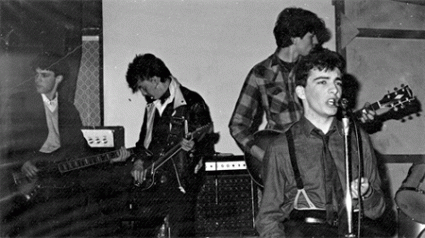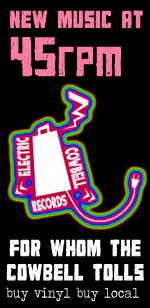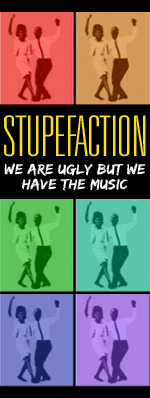 It’s not surprising that the kings of moody garage pop, Crystal Stilts would handpick unsung U.K. post-punk heroes Happy Refugees to play with them at the Knitting Factory in Brooklyn this Friday.
It’s not surprising that the kings of moody garage pop, Crystal Stilts would handpick unsung U.K. post-punk heroes Happy Refugees to play with them at the Knitting Factory in Brooklyn this Friday.
In case you haven’t heard, the members of Crystal Stilts are big-time crate diggers: these cats know more than a thing or two about not just the great records you know, but the ones you don’t.
So when it comes to those very special obscure records – the ones that fetch collector’s prices on eBay and elicit equal amounts sighs of wonder/gasps of envy from a small group of “in-the-know” music obsessives, chances are pretty good at least one of the Stilts owns a first-edition pressing. (The band’s new 5-song EP, “Radiant Door,” out on Sacred Bones, underscores their scholarly reputation with inspired covers of Lee Hazelwood’s “Still as the Night” and Blue Orchid’s “Low Profile.”)
For a certain type of independent music aficionado, Happy Refugees’ 8-track mini-LP, “Last Chance Saloon,” is a lost classic that’s right up there with the best work of the Television Personalities, The Monochrome Set, and The Fall.
Originally released during the peak of new wave’s pomposity in 1984, “Last Chance Saloon” was an excellent showcase of Happy Refugee’s unique blend of quirky, DIY garage-pop, shambling post-punk and delicate introspection. As much as the band celebrated classicist pop, they often erred on the side of the idiosyncratic, frequently bending and breaking conventions with a restless enthusiasm.
Caught in a sort of time-period purgatory between the fading embers of post-punk and the C86 scene to come, Happy Refugees’ fate seemed sealed from the start. It didn’t matter that the band wrote brilliant songs, had a unique and well-defined aesthetic (quick: how many post-punk bands can you name that had a full-time piano player?), and an underlying sense of poetry that ran through everything it did.
Just look at that album cover. It says so much, yet reveals so little…
Thankfully, the very good folks at Acute Records have just re-issued the mini-LP in question, now called “Return to Last Chance Saloon” and the label did an exemplary job. Along with all the tracks from the original mini-LP, the re-issue includes Happy Refugees’ “Warehouse Sound/Enshrined in A Mystery” single, originally released in 1982, as well as unreleased tracks and demos.
The tracks have been lovingly remastered for this release and the band sounds better than ever. It’s clear that a lot of thought and care went into this reissue—needless to say, it is highly recommended.
To celebrate the release of the re-issue and the band’s show with Crystal Stilts this Friday (they also have a second show on Saturday at the Cake Shop in Manhattan), I spoke with vocalist Tim Shutt and guitarist Paul Johnston.
When this project of re-releasing the Happy Refugees on Acute Records began, what was it like for you guys to go back and revisit this music? The thought occurred to me that being such outsiders has ended up been a blessing in disguise, at least in terms of the shelf life of your music. It holds up remarkably well.
Paul: My first thought was that the music still sounded fresh and relevant to me. I think that’s because we made the records without any regard for what was popular or commonplace at the time. I don’t view the record as a period piece. I’d be proud to release it today and I hope listeners share that.
Tim: In comparing what we did with the music I hear today…ignoring mainstream stuff and considering “indie” music, I can’t help but wonder, where is the ambition? Where are the risks? Where are the provocative lyrics, and twists and turns? These are principles that Happy Refugees held as essential.
Paul, you mention in the liner notes that the band formed with no preconceived idea of what you wanted to sound like. Can you talk a little about the process of developing Happy Refugees’ sound? I’m curious how a six-member band ended up with such a beautifully sparse sound.
Paul: When we started as a four piece, there was no fixed idea. Tim always had interesting lyrics and a left-field approach, and we tried to marry a degree of pop sensibility to that, but not too much. I thought it was important that the music provided a platform for the lyrics and performance, and for me, the Velvets were always a great reference point for that. I was always looking for a hook to sweeten the lyrics, to create a musical juxtaposition. Tim was always taking it away from the mainstream, and I was trying to keep it from falling off the edge. I think it was a good combination.
When Paul Harvey and Nick Flynn joined, we tried to maintain that basic dynamic, albeit with a fuller sound. Paul and Nick brought their own ideas and songs. On some songs, like “Inertia,” we did move to a heavier sound, but the soul of the band always lay in songs with space – songs that could breathe a bit when we played live. I hope we can capture that when we play again.
Speaking of the band’s unique sound, one of the things I appreciate most about your music is these sudden, unexpected left turns into the unusual. In “Hamburger Boy,” you go from this shambling guitar riff backed by driving drums to just finger-snapping and mock-falsetto vocals. In “Warehouse Sound,” you go from heavy emotional introspection with thudding percussion, sparse guitar, beautiful piano and almost whispered vocals to this wonderfully quirky, dare I say “punkified” Chuck Berry riff, and then right back into a deeply moving, emotional climax. It’s extraordinary. Is it fair to say the band took special delight in taking these playful, almost subversive approaches to conventional song structures?
Paul: The first bands that Tim and I played in all took late 70’s New York as the reference point. Televison, the Dolls, Richard Hell, Patti Smith, Talking Heads. What a fantastic period in music, and these bands informed what was called the “Alsager Sound.” Bands like Colors Out of Time and The Pits produced intelligent, sometimes belligerent music, underscored with an unshakeable attitude that they were making the most interesting music of the day. So that set the bar pretty high for Happy Refugees. I think that level of peer group influence was really important in pushing us to make the most interesting music that we could. And it means a lot to me that guys from those bands like what we did, and love what is happening now.
Tim: I have always considered myself to be a maverick in terms of my approach to song writing and to some extent, life. In fact, very few of the songs were written in the same way. The idea was to create musical and lyrical serendipity to engage with the listener. In terms of the musical backdrop, I was constantly challenging the other guys, whether it was in writing the songs, recording or playing live, to try and make the songs exceptional.
Tim, can you talk about the band’s lyrical pre-occupations? I find it fascinating that “Enshrined in a Memory” is about your late grandmother. What is “Hamburger Boy” and “Warehouse Sound” about?
Tim: Most of the songs lyrically reflect my feelings at the time: alienation, love, life, bereavement, hopes, fears. “Enshrined in a Memory” captures my feelings of loss after an unexpected death in my family. “Hamburger Boy” deals with the way people’s lives are being manipulated by large corporations. “Warehouse Sound” attempts to reflect the violent mood swings of a woman struggling to find happiness. In my mind the woman is a beautiful, intelligent, lovable woman with an attractive personality who lurches from being very serene to a frantic state. I think the music reflects this.
There is also commentary on the environment around us with “Last Chance Saloon” and Nick Flynn’s “Kick in the Shins.” These songs are probably even more relevant today than they were then.
Tim, you mention in the liner notes that the band played live in London a fair amount in the first half of 1983 – what was that experience like for the band? I tend to think of London, especially around that time, as being very “showbiz.” How did the audience react to such idiosyncratic sounds? Happy Refugees were obviously a far cry from a lot of the bands getting attention in London at the time.
Tim: There were very few places for a DIY band to play. London had moved on from the punk thing and was onto New Romantic and synth pop. If you weren’t signed, there were just a few venues. Also, we couldn’t afford to play too often because of the expense or the time commitment. When we did play, I think many people dismissed us as not being able to play or sing well enough. They couldn’t focus on the performance or the songs.
As we have been preparing for the New York shows, I think we have surprised ourselves just how good we are in terms of playing. However, it is the songs and our loyalty to getting them heard that continues to drive us. We all believe in our music.
Happy Refugees seemed to emerge at a time when the feverishly creative post-punk period was starting to wane and the music press starting focusing more on new wave and blandly commercial sounds. Can you talk about the challenges of trying to get a foot in the door during this period?
Tim: It was tough. There were two main routes. One was the long haul, to build up a local following, mainly by playing live and hope you got signed by a record company. That was not really an option for us. The other way was to put out your own records and try and attract interest from the music press, which was very influential at the time, particularly NME, or get played on Radio 1. This is the route we tried, but you were competing against the might of a music industry that employed professional pluggers to get to the people who would make a difference. I tried hard, but in the end I think that many of these guys were interested in finding bands that were part of the next wave. We never were and never would be the kind of thing they were looking for. I think there are far more opportunities for us to find our audience now.
Paul: I feel much more comfortable with the routes that we have now than we did back then. The internet has changed everything in terms of how people can access music, and it is much less controlled than it was when we started. Dan Selzer of Acute came to us primarily as a fan wanting to re-release our songs, and he has done a fantastic job in getting the record together; we’re really grateful for that. And beyond Dan, a further circle of like-minded people has emerged to support us, with the internet providing a springboard for all of that. You have to remember when we started there was no internet (honestly!), and a band like us really benefits from being able to connect without having to dilute what we’re about.
I’ve always thought the album cover art to Last Chance Saloon is particularly striking. Tim, you say in the liner notes that it was your concept and that you enlisted artist Ivan Unwin to realize it. Can you talk about working with Ivan on the concept and seeing it come to life?
Tim: I wanted to emphasize the key lyrics in the song “Last Chance Saloon”: “The top drawer is full of roses and the bottom drawer holds nothing.” I wanted to show a shambolic state with drawers tumbling out, highlighting the roses and that the bottom set was empty. Ivan got this straight way. Almost immediately he set everything up in a spare room in his house. He decided to include all the everyday objects flying around and the girl Cathy. I think this was a good move. What made me laugh was that he wanted to create a hazy atmosphere so he threw flour into the air. When the pictures were taken, Cathy was almost choking. He did a great job for me.
Tim, the original Last Chance Saloon mini-LP was released on your own label imprint, Gymnasium Records—what was that experience like for you to be the one putting out the record? Can you talk about the challenges of trying to get the record out to the right shops and into the hands of would-be fans?
Tim: Firstly, the idea of Gymnasium was to be fresh and energetic. I had come through a difficult time from transitioning from the previous band and I wanted a clean break, a new start.
In making The Pits’ “One Hell of A Kiss” single, the record pressing plant had gone bust. I had to pay a second time for the pressings. The wrong version of the song was put on the record because there were no test pressings. I was taking legal action. I ended up with 2,000 copies of the Garage Class’ “Terminal Tokyo” single with no label on them, no sleeve, and I had no band. Comparatively, “Last Chance Saloon” was a breeze. We had already put out “Warehouse Sound/Enshrined in a Memory” as a single. I cannot remember how, but I had managed to persuade Red Rhino to distribute the single. This was probably on the strength of a review and they seemed to like it a little, but not a lot. Without the distribution, we wouldn’t have gotten as far as we did.
Paul, you mention in the liner notes that there’s “a stack of better unrecorded material, as is always the way.” Have you guys thought about getting back into the studio to finally record these songs? Are you open to the possibility of doing more shows beyond these two NYC gigs coming up?
Tim: It’s that difficult second album syndrome … It is just a matter of time I guess.
Paul: Come to the shows and let us know what you think of some of the unrecorded songs. We are here to serve…
In the liner notes, you write that the band “felt excluded in many ways: never reaching much of an audience or selling many records.” But obviously, most of the bands that are very successful commercially aren’t very interesting musically. Do you take any solace knowing that the record has become a wonderful discovery/cult favorite over the years for those “in the know” music fans? And now of course, there is the possibility that a greater number of music fans may appreciate your work…
Tim: The thing that is really doing it for me with the re-release is that from the feedback we are getting it is clear that people do really get what we did musically and lyrically. We wanted to make classic, quirky, eclectic pop vignettes bursting with ideas and emotions; real music for real people. If we now find our long lost audience, that is fantastic for us. It is like we buried some treasure, forgot where we buried it and then found it again. We will be playing many other of our songs live in New York. There is more to come from Happy Refugees and I promise our ideals have not changed with time.
Thanks very much to you both!
Tim: Thanks Rick!
Happy Refugees Facebook | Twitter
Acute Records Facebook |
SHOW INFORMATION:
Fri 3/9
Crystal Stilts w/ Happy Refugees, McDonalds (the band)
Knitting Factory, 361 Metropolitan Ave., Brooklyn, NY 11211
Doors at 7pm, first band at 8:30pm, $8 cover
Sat 3/10
Happy Refugees w/Regal Degal, Sapphire Mansions, Suspensors
w/ DJs Dan Selzer (Acute Records), Kevin Pedersen (What’s Your Rupture? Records) & DJ iDeath
Cake Shop NYC, 152 Ludlow Street, NYC 10002
Doors at 8pm, first band at 9pm, $8 cover, 21+











